Setting Up WordPress Content Lockers – The Complete Guide
Do you want to set up WordPress Content Lockers?
Content lockers allow you to restrict access to your content until your site visitors have performed specific actions. These actions could be many things, such as subscribing to your newsletter, sharing your post on social media, registering on your site, or even paying a small fee for your content.
In this article, we will learn about content lockers and content locking, their benefits, and how to set up content lockers on your WordPress site.
What is a WordPress Content Locker?
A WordPress content locker is a tool that allows you to block access to content from your site visitors. Content lockers usually will enable you to restrict any form of content, including blog posts, downloadable materials, pages, software, and more, until your users perform a specific action.
Content lockers are valuable tools but can quickly become annoying to your visitors if not used carefully. Selective use of content lockers by giving access to some free content is a great way to balance the scale and not annoy your visitors.
The ideal thing is to use content lockers to protect high-quality or premium content that will add significant value to your visitors; this content could be an ebook, online training, software tools, etc.
Why Use Content Lockers?
Various benefits can be derived from using a content locker on your WordPress website. The benefit you will derive will mostly depend on your end goal for setting up the content lock on your website. Below are some of the most popular benefits that can be derived from WordPress content lockers.
List Building: one of the most common purposes of content lockers has been list building. Locking away high-quality content and requiring users to signup into your email list for access is an excellent way to grow your email list rapidly.
Social Media Engagement: content lockers are also great for increasing social media engagement. You can lock your content in exchange for social shares and social media followership. As a result, you build your social media following and drive traffic to your website.
Monetization: Using a content locker is also an excellent way to monetize your website. Many website owners put their content behind a paywall and require their visitors to subscribe to a membership plan or buy a product before they can access this content. Paid subscriptions for valuable content such as ebooks, software, training, or even articles can be a good source of revenue.
How to Setup Content Lockers on Your WordPress Site
In the previous section, we learned about content lockers and their benefits. In the sections below, we will dive into the installation and configurations of content lockers on our WordPress website.
The WordPress platform does not come with an in-built content-locking feature, so we will need to employ the help of a content-locking plugin to be able to restrict content on our website.
In this article, we will learn how to use the MailOptin plugin to lock content for email list building and use the ProfilePress plugin to lock premium paid content.
How to Setup ProfilePress WordPress Content Locker
ProfilePress is one of the best WordPress membership plugins enabling you to sell digital products, create membership sites, and lock your website content.
ProfilePress is a feature-packed plugin. It comes with a content-locking feature, payment gateway integrations, a drag-and-drop form builder, and many more features you will need as a website and business owner.
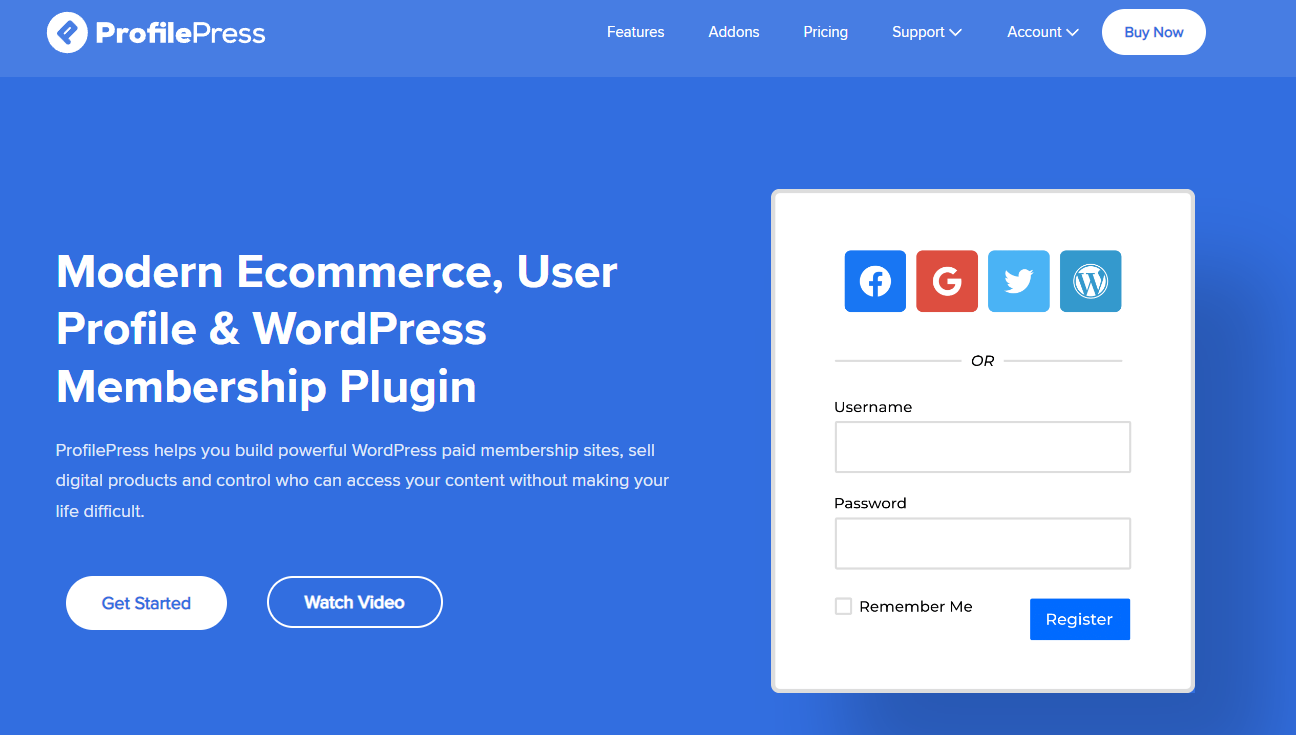
In the sections below, I will show you how to install and activate ProfilePress, set it up, and use it to lock Premium Paid content on your WordPress site.
Install and Activate ProfilePress
The first step in the process will be to install and activate the ProfilePress plugin. You will need to purchase a ProfilePress Pro License and install the ProfilePress plugin. To do that, head to the ProfilePress website to purchase a suitable license plan.
After purchasing your copy of the ProfilePress Plugin, you will receive a confirmation email with a link to download the plugin zip file and your license key. You can also download the plugin from your account page on the ProfilePress website.
Once you have downloaded the plugin, login to your WordPress admin dashboard, and navigate to the Plugins page; click on the “Add New” button and click “Upload Plugin.”
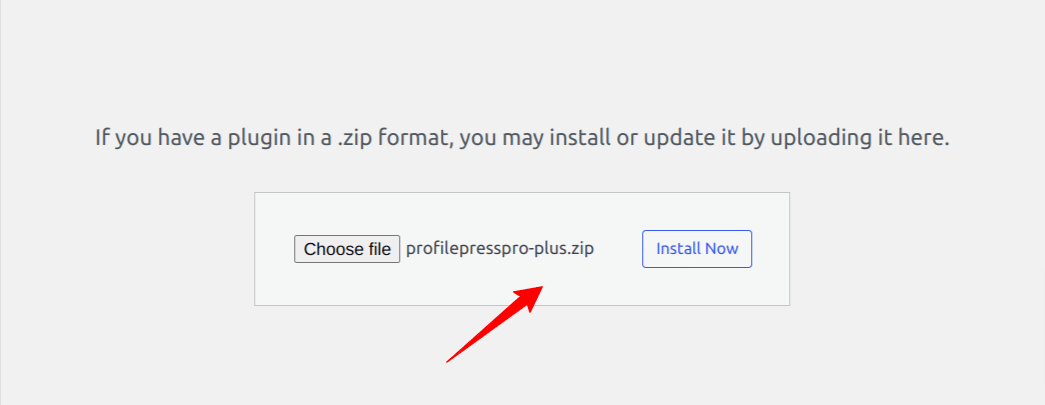
Next, click “Choose file” to select the previously downloaded plugin zip file. Click “Install Now.”
After installation is complete, click the Activate Plugin button.
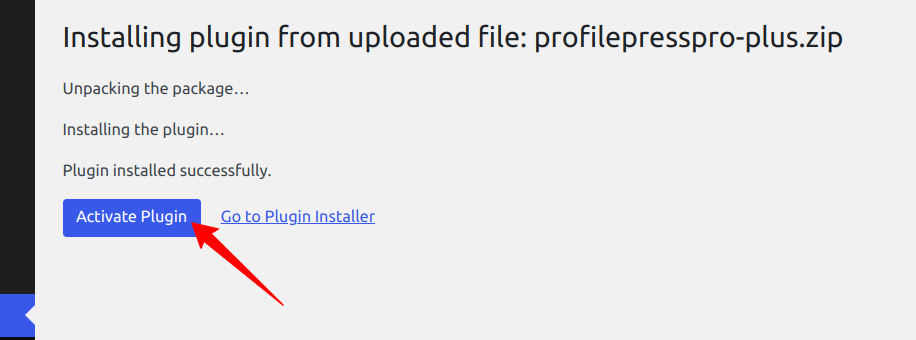
At the top of the page, you will see a notification that says, “ProfilePress needs to create several pages,” Click on the “Create Pages” button to complete the plugin setup.
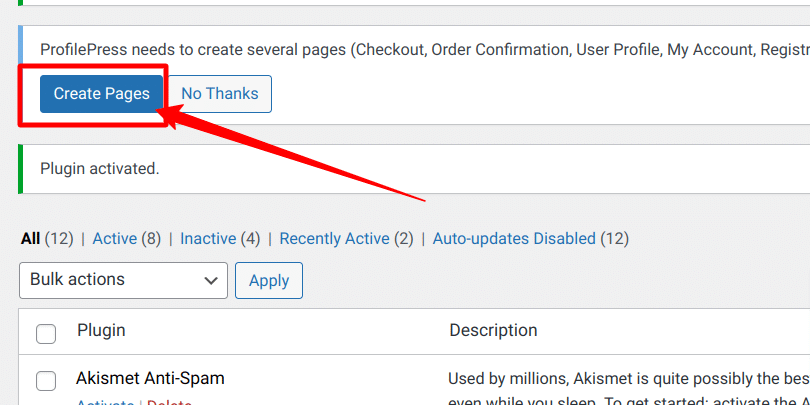
If you do not see this notification, navigate to ProfilePress > Dashboard and click the “Create pages” button to complete the plugin setup.
With this done, we have completed the initial setup of the ProfilePress plugin on our WordPress site.
Creating a Content Locker
ProfilePress allows us to protect various forms of content in WordPress. You can lock pages, posts, child pages, child posts, categories, tags, and more.
You can restrict content to a specific user group, such as subscribers of a paid membership plan, logged-in users, logged-out users, or even everyone.
To get started, Navigate to ProfilePress > Content Protection and click the Add a New Protection Rule button.
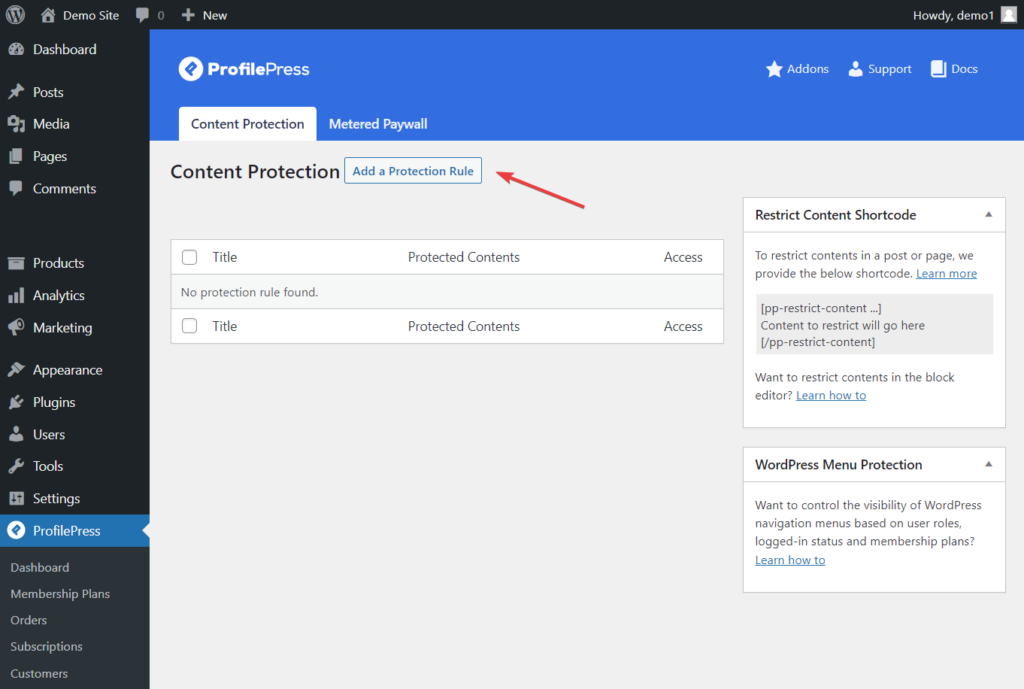
When you click the button, you will be taken to the Protection Rule editing page. This is where we will configure the behavior of our content locker.
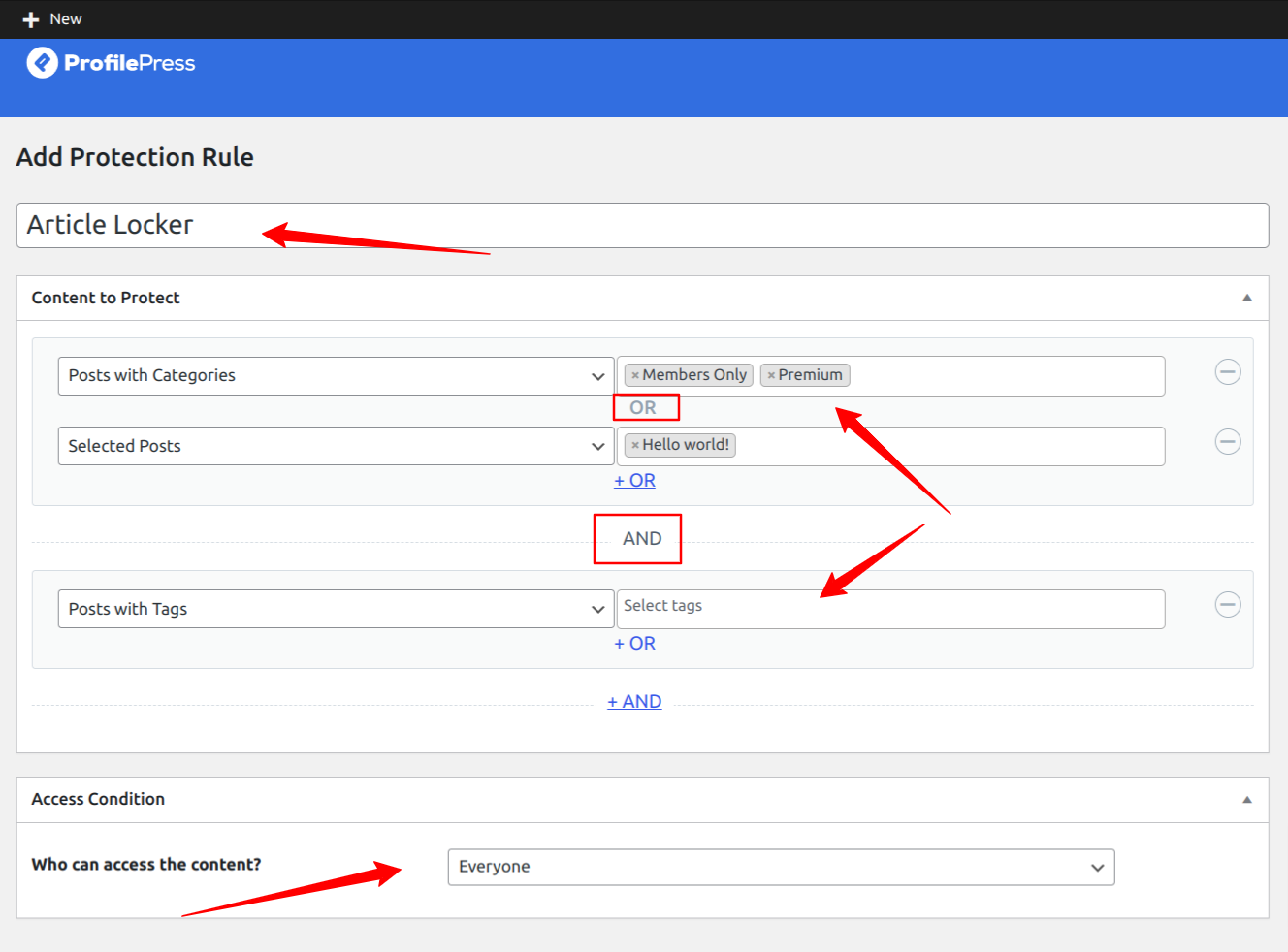
Enter a descriptive title for the rule you are creating, select the content you protect, use the logical OR/AND to set the rules, and use the access condition to select who can access the content.
The Access Condition section allows you to assign who can access the content you want to protect, such as:
- Everyone (all users will have access to the content),
- Logged-in users (only those who are logged in can access the content)
- Logged-out users (only thare not logged in to your website can access the protected content).
The Logical AND rule only kicks in when all grouped conditions are true, and the Logical OR rule happens when one of the conditions in a group is true.
In the screenshot above, we used the OR logic, where the protection rule will kick in when anyone accesses either of the selected post or pages. Of course, this means you want everyone to access the selected post and page.
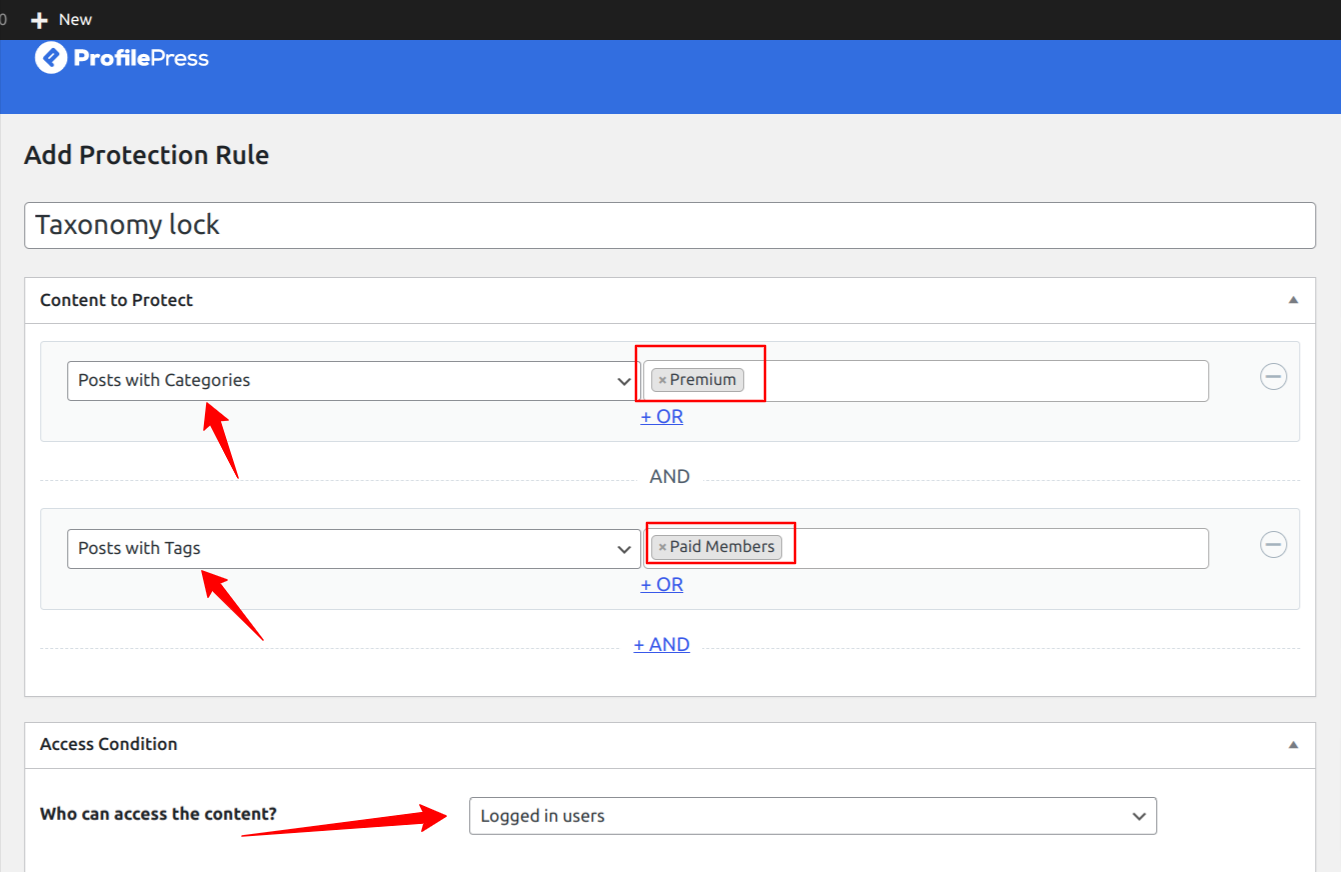
The rule above will restrict posts on your site that belong to the “premium” category and “Paid members” tag to logged-in users only.
Next, you must go to the Access Condition section on the rules editing page to configure who can access the premium content.
In the Access Condition section, select Logged in users from the dropdown menu against the “Who Can Access the Content?” option.
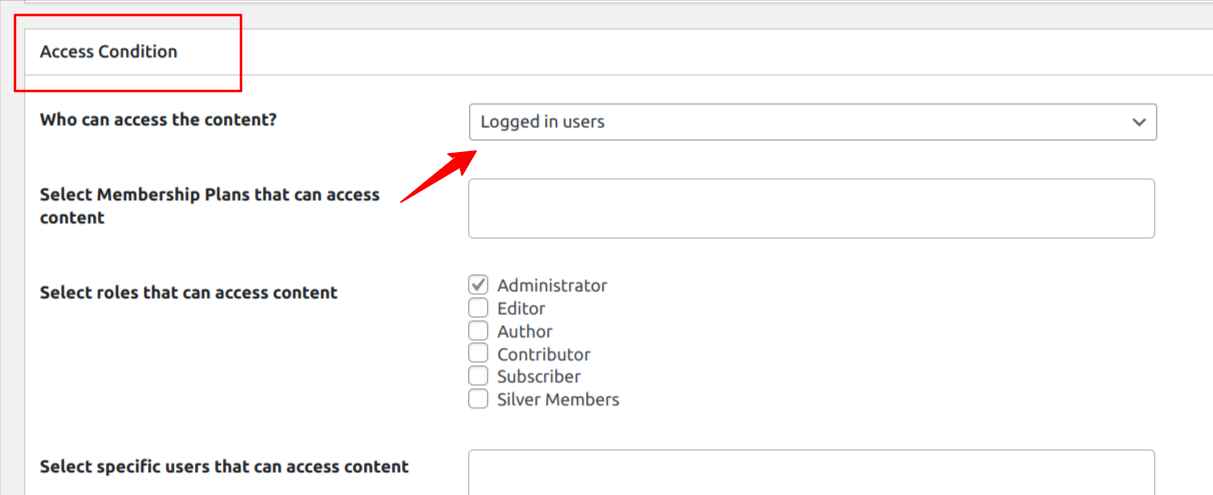
You can show unauthorized users the global restriction message, a custom message, or the post excerpt or redirect them to a specific page.
As soon as you select the Logged in users option, several new options appear in the Access Condition section.
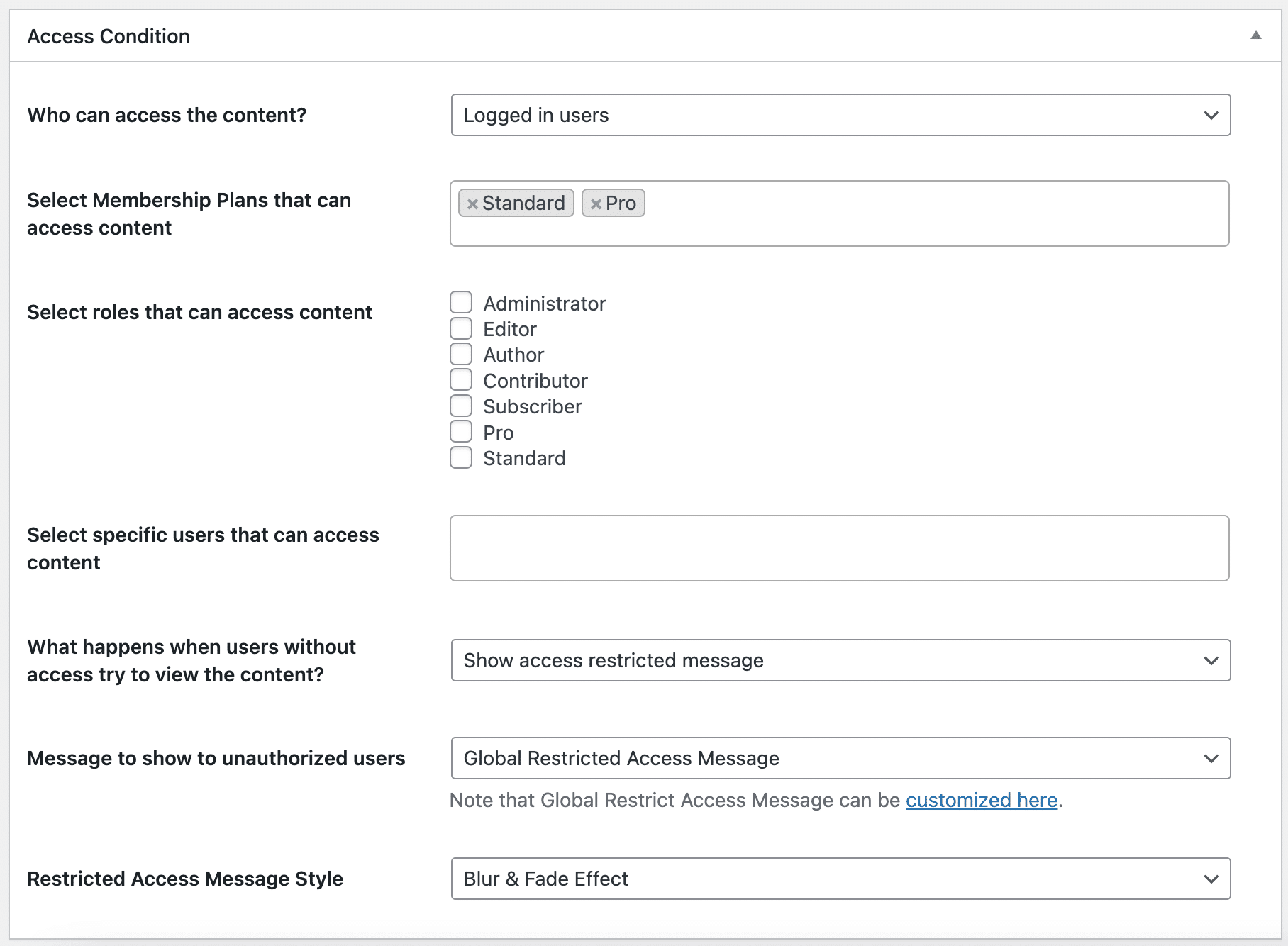
Next, go to the Restricted Access Message Style Option and select Blur & Fade Effect from the dropdown menu. Next, under Message to Show to Unauthorized Users, select the Post Excerpt + Global RestrictedAccess Message.
Hit the Save Rule button to save your setting.
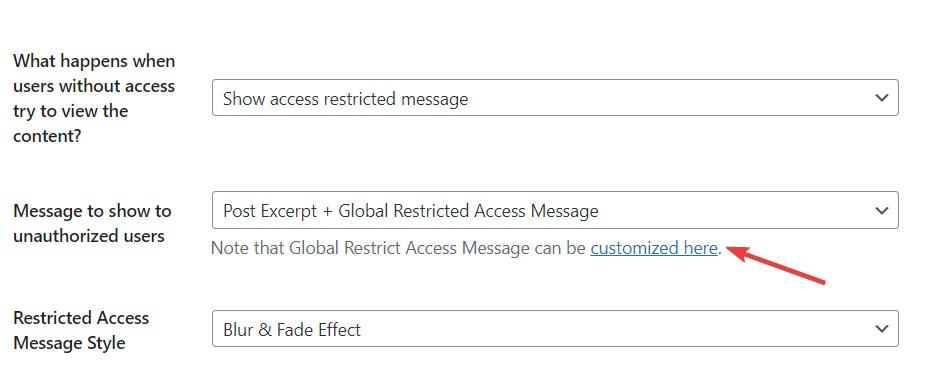
Click on the customized here link, as shown in the image above, to add a custom message for your content lock. This message should inform the visitors that they need to become premium members to access the full content.
If we visit any locked posts based on the above rules, we will see a notification as shown below.
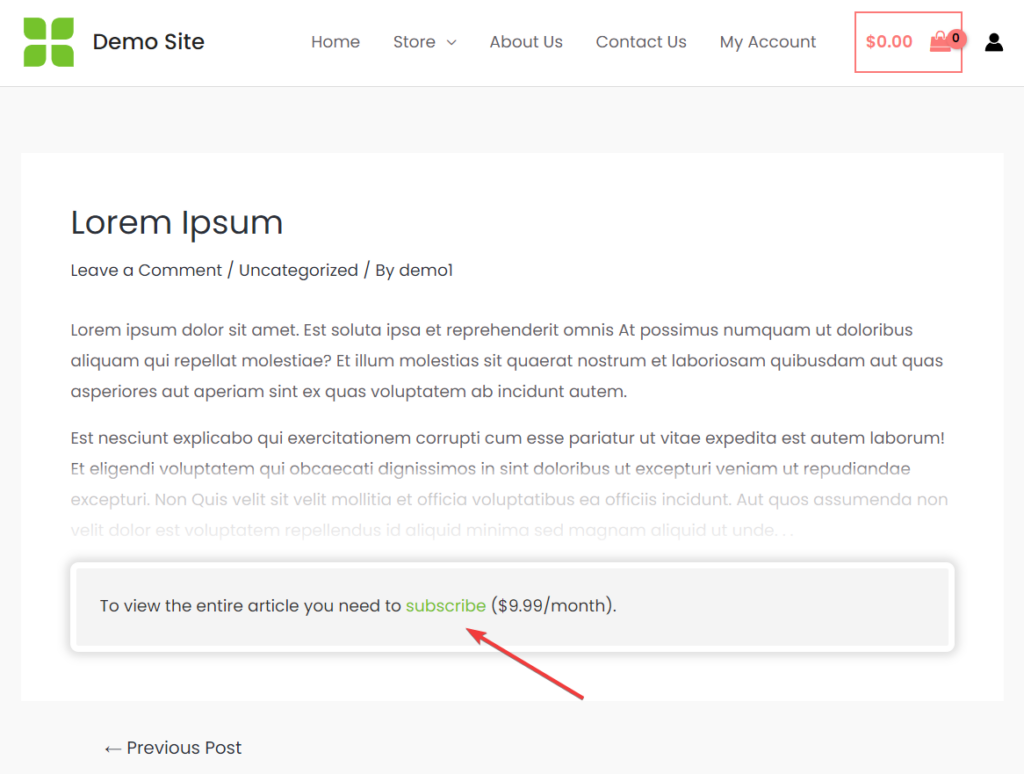
By completing this setup, we have successfully added content locking to all posts in the premium category, which paid subscribers or selected user roles can only access.
Note that you can create as many content protection rules as you want. You can also deactivate/activate any rule from the Rules listing page.
How to Setup Metered Content Lock with ProfilePress
Aside from the content locking feature above, ProfilePress supports metered content lock. With the metered content lock, visitors can access all content, but they must pay after a certain number of views.
For example, visitors can read two free articles daily, and then all content becomes locked until they pay for a membership plan.
Activating the Metered Paywall Addon
To add metered paywall content locking to WordPress, we need to activate the metered paywall addon in the ProfilePress plugin.
Navigate to ProfilePress > Addons and toggle on the Activate button in the Metered Paywall section.
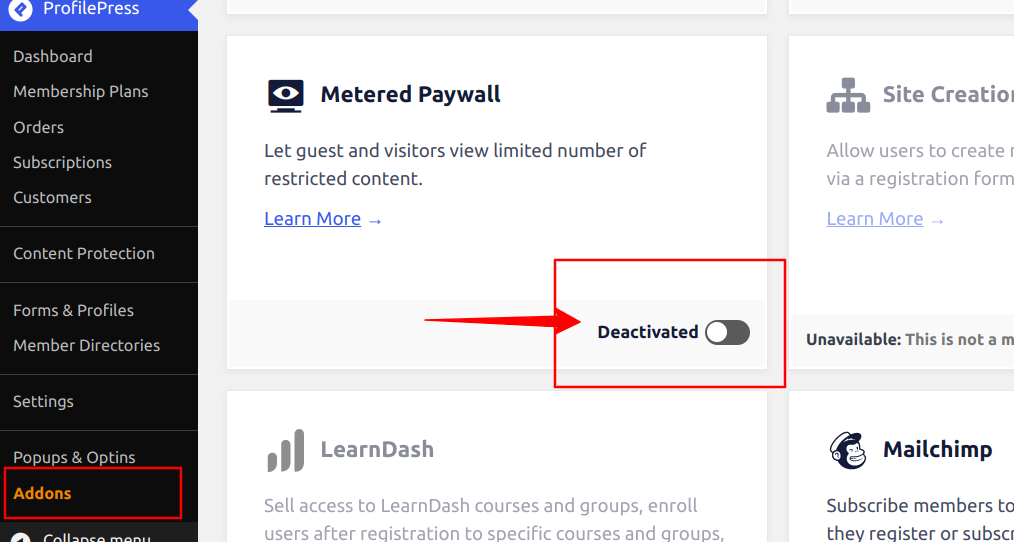
After activating this addon, we will have to go through four steps to set up the metered content lock:
- Restricting content
- Setting up a metered paywall
- Preventing abuse of the paywall
- Adding countdown slider
i. Restrict Content
First, restrict your WordPress site content by following the guidelines below.
Navigate to ProfilePress > Content Protection and click the Add a New Protection Rule button.

Add a Title on the next page, and select All Posts from the dropdown menu under Content to Protect.
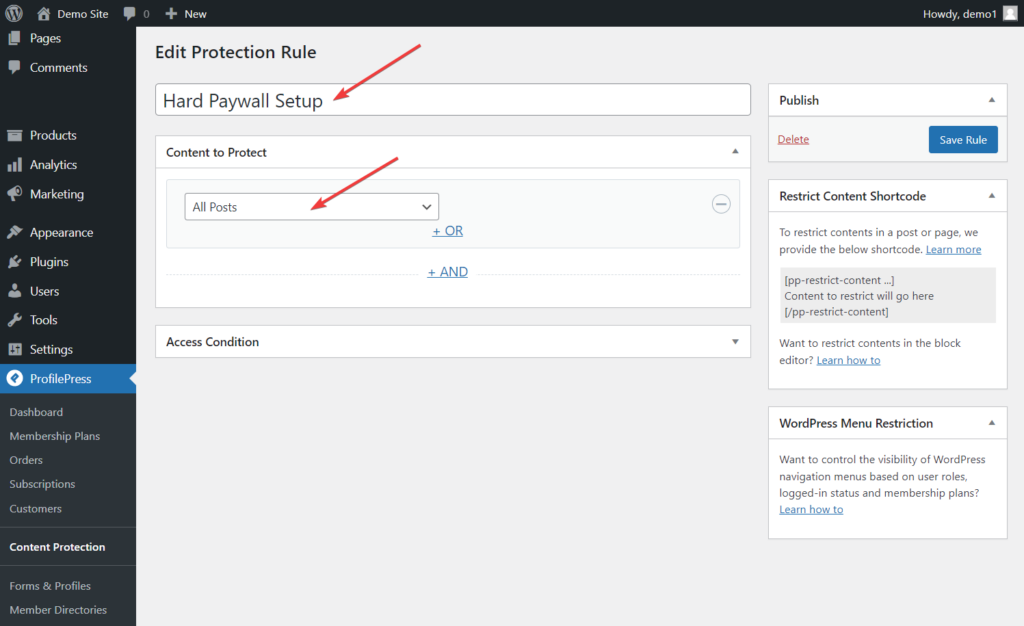
Scroll down to the Access Condition section, and from the dropdown menu against the Who Can Access the Content option, select Logged in users.

As soon as you select the Logged in users option, several new options appear in the Access Condition section.

Firstly, go to the “Select Membership Plans That Can Access Content” field and add the membership plan you created in the step above.
You might also want to select additional Roles to access the content besides paid members with an active subscription. You could select the Administrator and Editor roles.
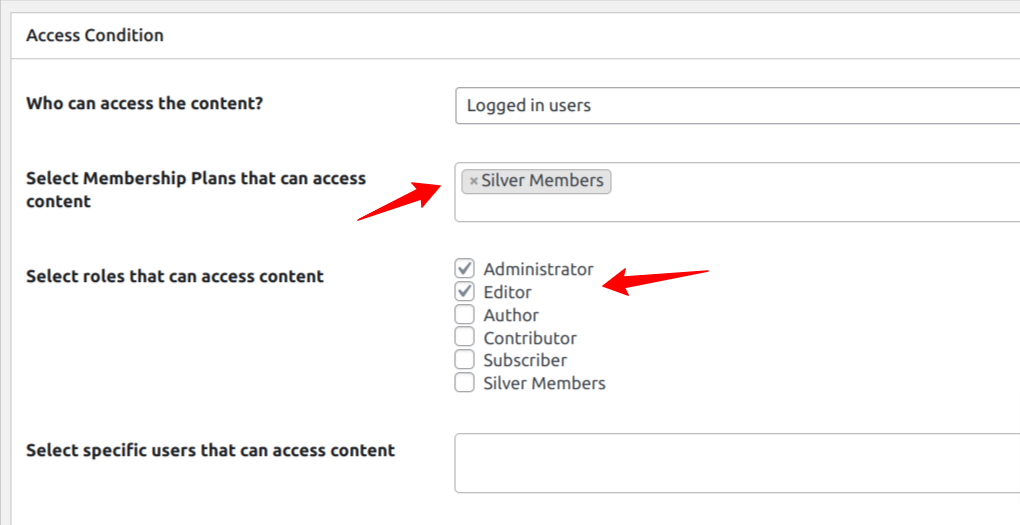
Tip: Whichever user role you select, choose Administrators as well because you would want admins to access your site’s content.
Next, select the Restricted Access Message Style Option and select Blur & Fade Effect from the dropdown menu. Next, under Message to Show to Unauthorized Users, select the Post Excerpt + Global RestrictedAccess Message.
Hit the Save Rule button to save your setting.

Click on the customized here link, as shown in the image above, to add a custom message for your content lock. This message should inform the visitors that they need to become paying subscribers to access the full content.
Alternatively, you can select “Post Excerpt + Custom Message” as the Message to show to unauthorized users if you don’t want to use the global restricted message.
When all is done, hit the Save Rule button and proceed to the second step, which involves opening the Metered Paywall settings page beside the Content Protection menu tab at the top.
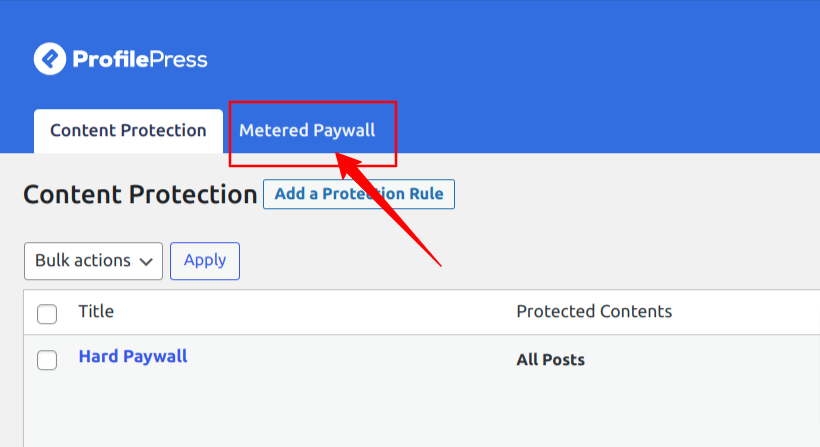
ii. Set Up Metered Paywall
You need to modify the first three options on the Metered Paywall page. Let’s take a look at each option and try and understand what they mean:
- Reset limitation after allows you to choose a length of time when visitors can once again read your posts for free.
- Restrictions allow you to choose which post types you plan to restrict and how many posts, pages, or custom post types you will offer for free.
- Total free views allow you to define the number of posts a visitor can view for free. This is a global setting, and it will override the previous setting on free views.
Hit the Save Changes button to save the modifications.
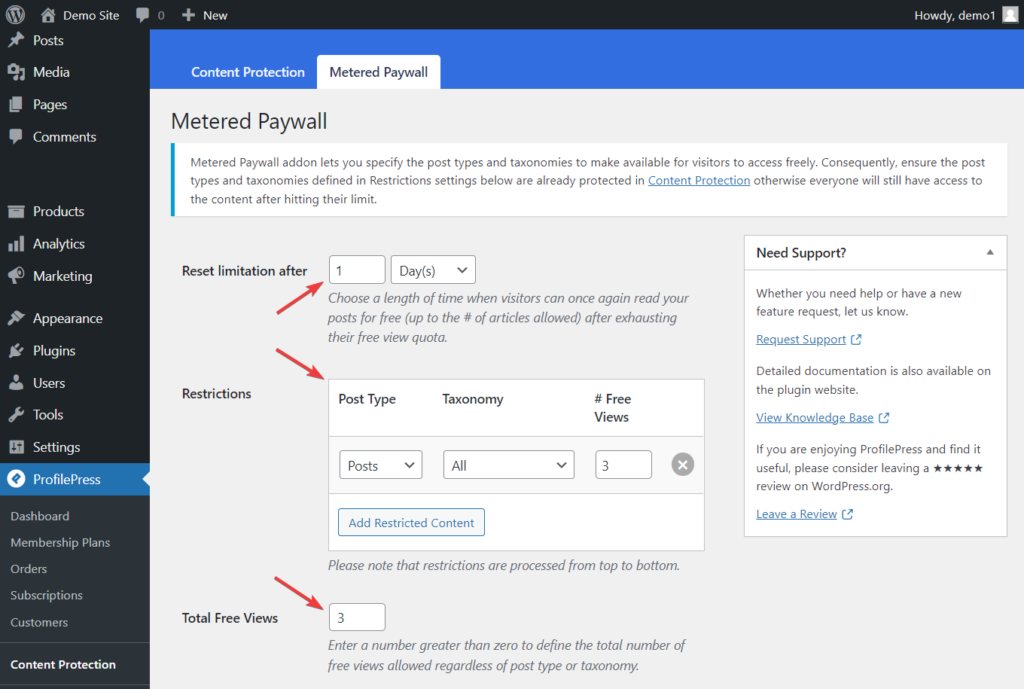
iii. Preventing Abuse of the Paywall
After setting up the metered paywall, you need to ensure that your premium content is protected from access via an incognito browser.
ProfilePress has an IP Blocker feature that stops readers from using the incognito mode or private window in their browser to get around your paywalls by storing the IP address a visitor comes from.
If the visitor uses their free article meter and then switches to an incognito mode, private window, or a different browser, they will still get stopped and asked to subscribe.
To set this up, go to the Metered Paywall > IP Blocker and select the Enable option to enable the feature. Then, hit the Save Changes button before exiting the page.
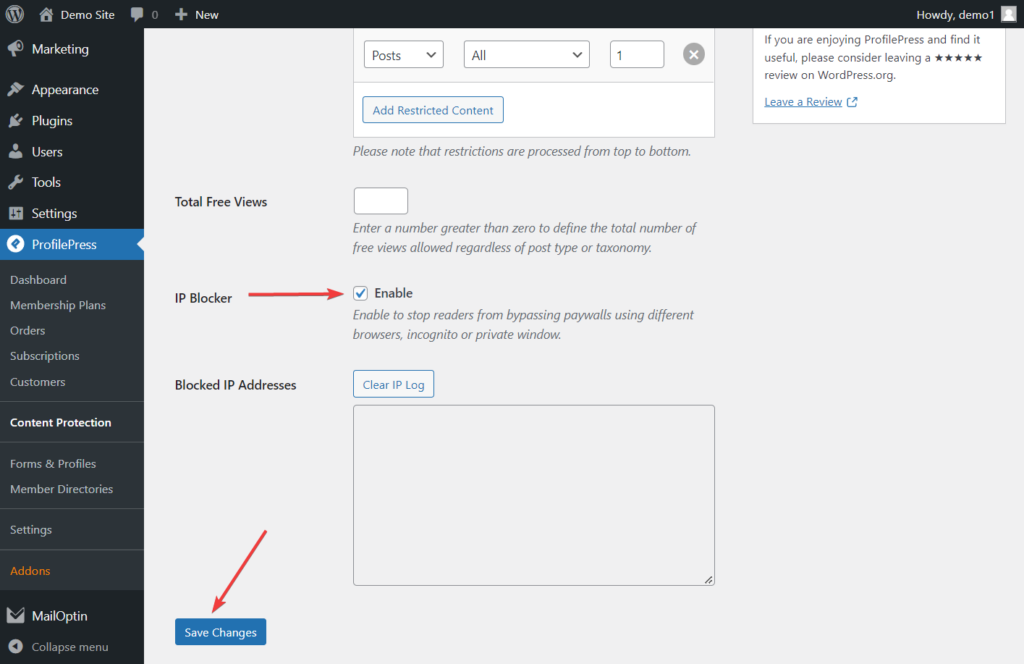
iv. Add a Countdown Slider
The Metered Paywall addon can display a customizable slide box on restricted content to let guests and non-members know how many views they have left before they are required to subscribe. This feature can be seen on popular websites like The New York Times and Medium, allowing visitors to read a few premium articles for free before asking them to sign up for a subscription.
When a user views restricted content, a notice slides in from the bottom left of the screen after a few seconds alerting them to how many free articles they have remaining.
Open the Metered Paywall option on your WordPress dashboard and go to the Countdown Slidebox section.
Select the Enable option and add the link to your pricing or checkout page in the Button Link option. Visitors will use this link to go to a page where they can sign up and make payments.
You can change the button text and message and log in to the text if you need to.
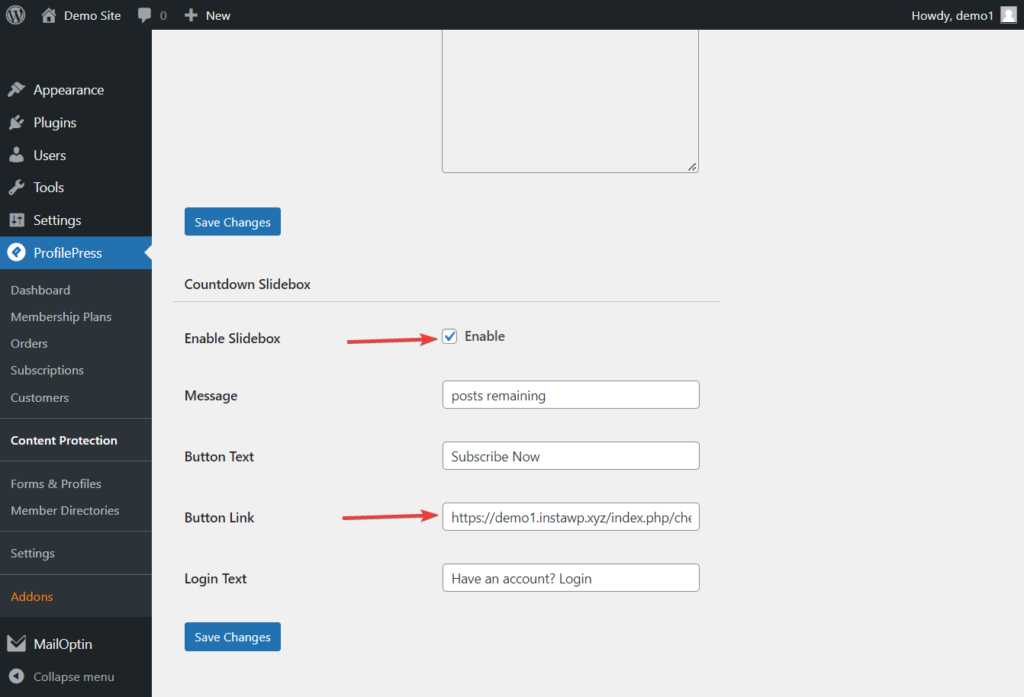
When you are ready, hit the Save Changes button, and the countdown slider will be added to your WordPress site.
That’s it. You have now completed the setup of a metered content lock on your WordPress website.
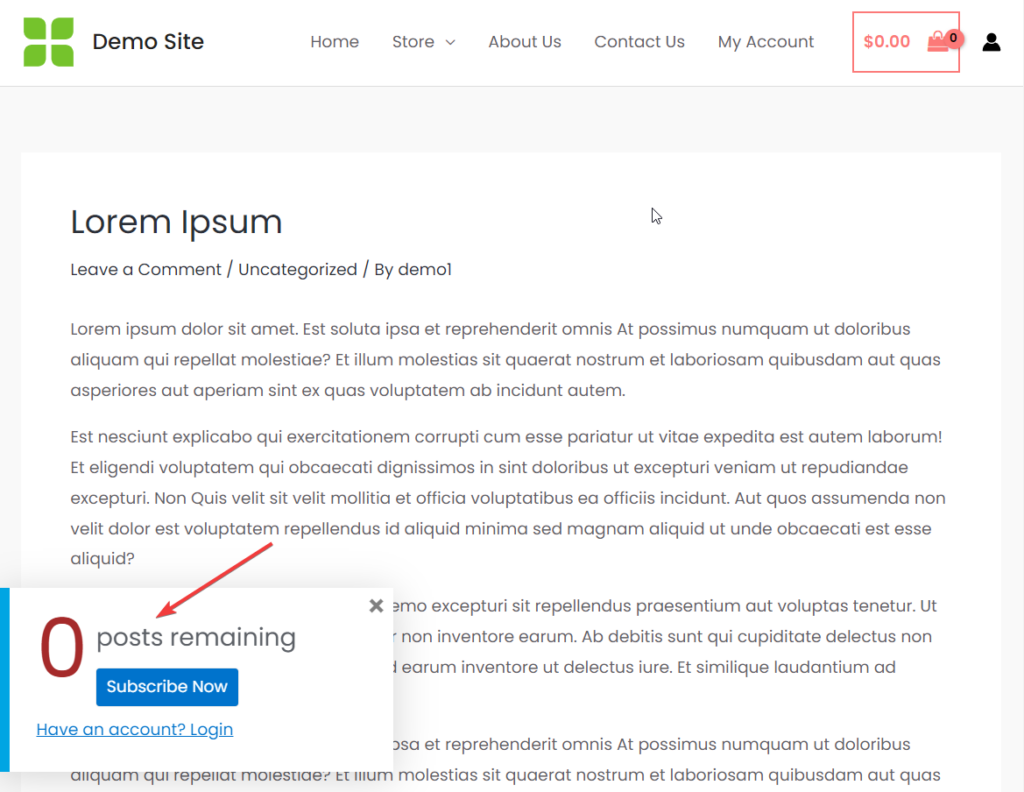
How to setup MailOptin WordPress Content Locker
MailOptin is one of the best WordPress content lockers out there. It is an all-in-one solution for converting site visitors into subscribers. It allows you to create, customize, and showcase professional opt-in boxes on your WordPress site.
It allows you can lock specific parts or pieces of your content on your site and ask site visitors to perform particular actions before accessing the restricted content. It also comes with an easy-to-use form builder that lets you create attractive-looking pop-up lightboxes and display them based on certain conditions.
Now, let us install and activate MailOptin, set it up, and use it to lock content on our WordPress site.
Step #1: Install and activate the MailOptin plugin
The first step is installing the MailOptin plugin, which you can easily do from your WordPress dashboard.
You will need to purchase a MailOptin License and install the MailOptin plugin. To do that, head to the MailOptin website to purchase a suitable license plan.
After purchasing your copy of the MailOptin Plugin, you will receive a confirmation email with a link to download the plugin zip file and your license key. You can also download the plugin from your account page on the MailOptin website.
Once you have downloaded the plugin, login to your WordPress admin dashboard, and navigate to the Plugins page; click on the “Add New” button and click “Upload Plugin.” Upload the zip file and install and activate the plugin on your WordPress site.
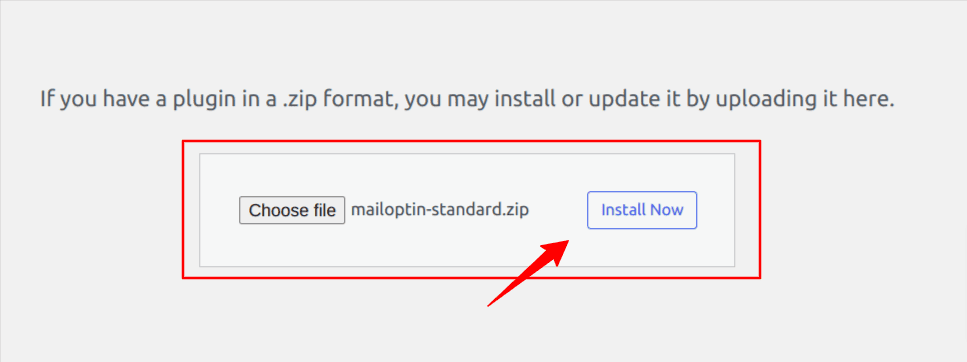
Step #2: Create and customize your opt-in form
With the MailOptin plugin installed on your site, navigate to MailOptin > OptinCampaigns and click the Add New button.
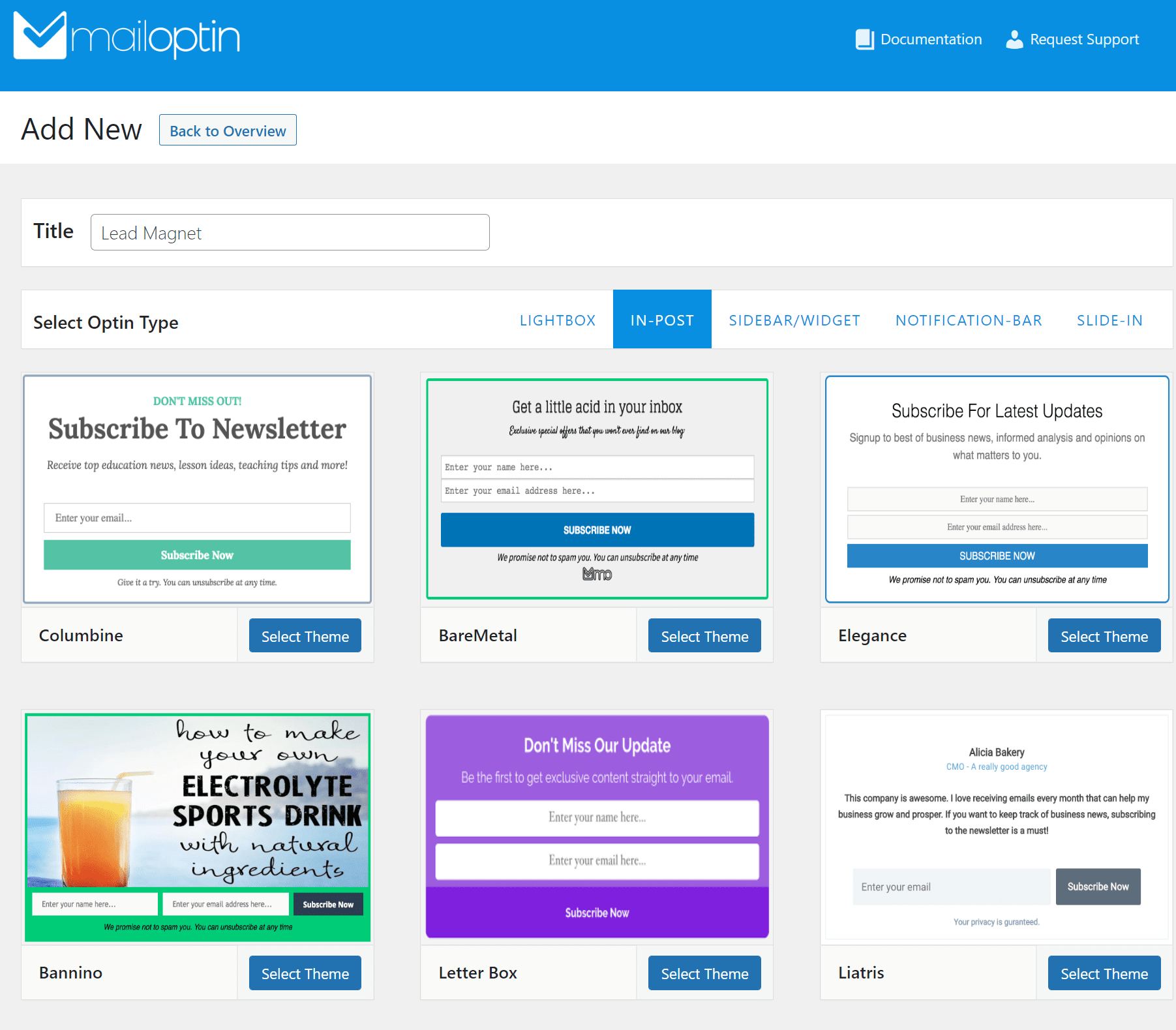
Enter a name in the Title field and select In-Post from the Select Optin Type section.
Next, select the template you want to start customizing. We’ve decided to go with the Letter Box theme for this example. Once you click on the Select Theme button, you will automatically be redirected to the customization page.
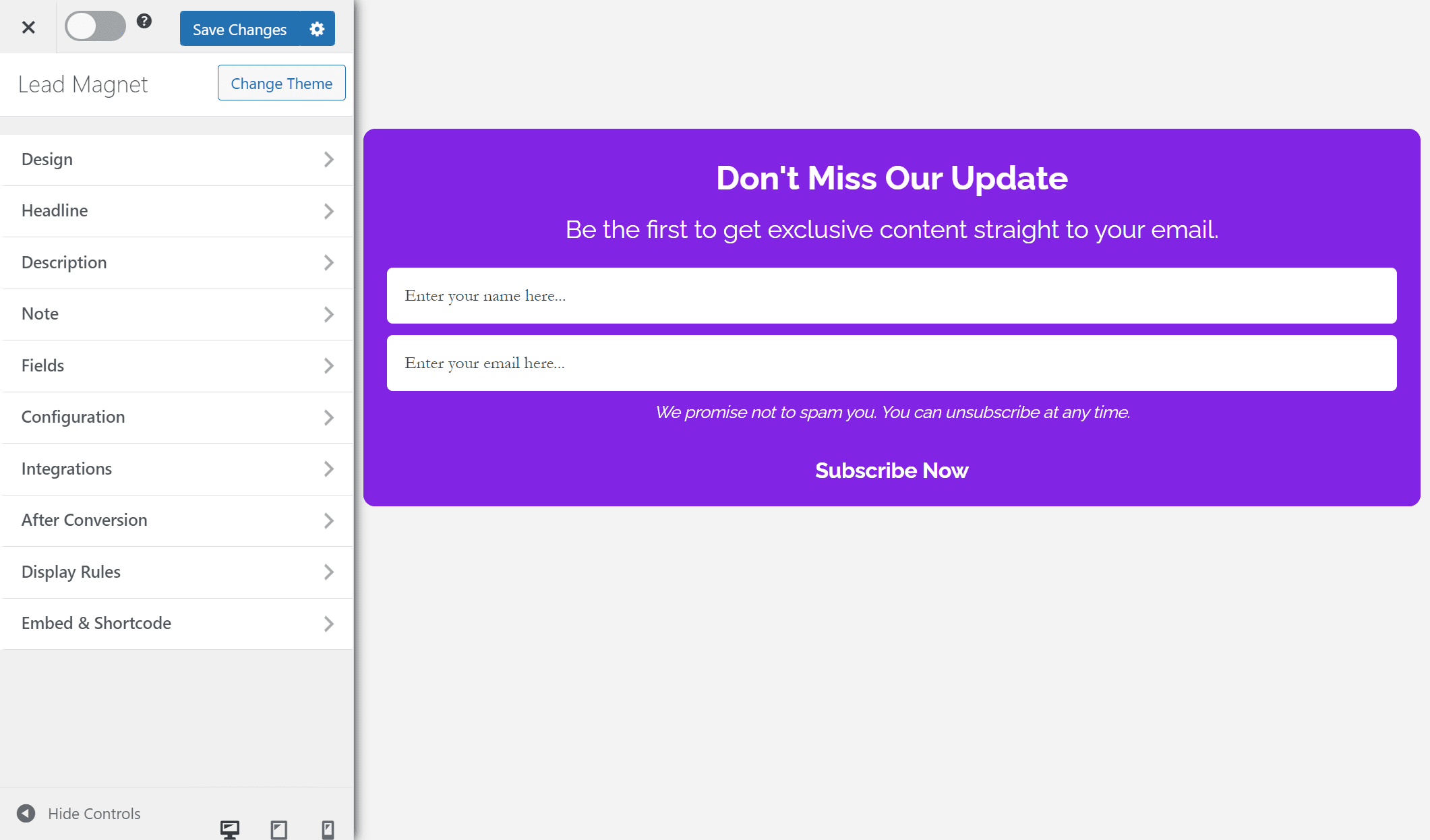
Using the options available on the form editing page, you can customize the opt-in form appearance and feel on the front end of your WordPress site.
Click on the Design tab to customize the background color of your opt-in form. You can customize the typography using the Headline and Description menus and set text colors.
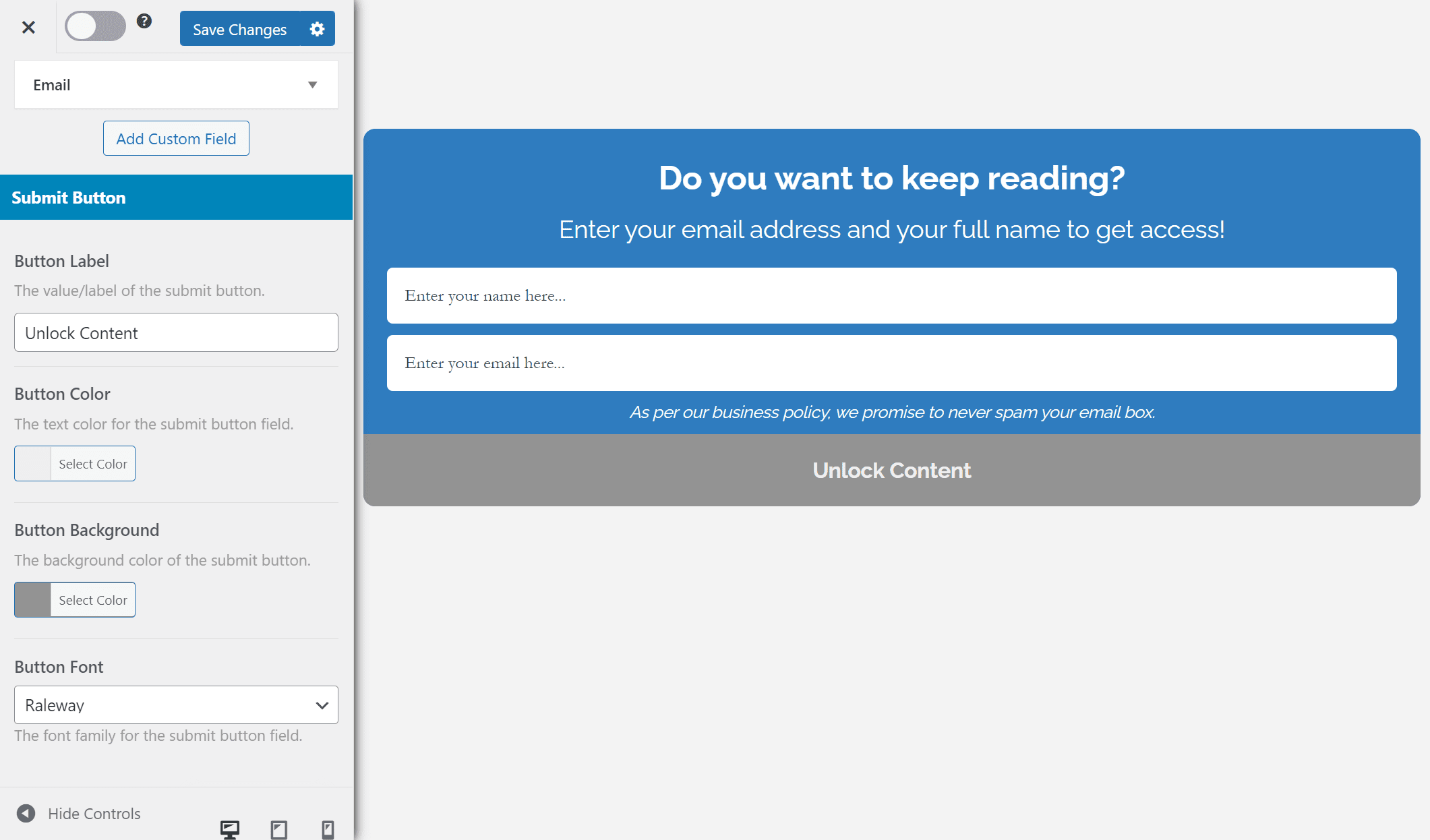
It’s also essential to display custom button text for the content locker to look professional and relevant to your audience.
Go to the Fields section and scroll down to the Submit Button section. Enter the custom text using the Button Label text field and set the button color.
Step #3: Create a WordPress content locker
With your opt-in form looking precisely how you want it, click the Integrations button and select your email service provider using the Select Integration dropdown menu. As an example, we’re using Mailchimp.
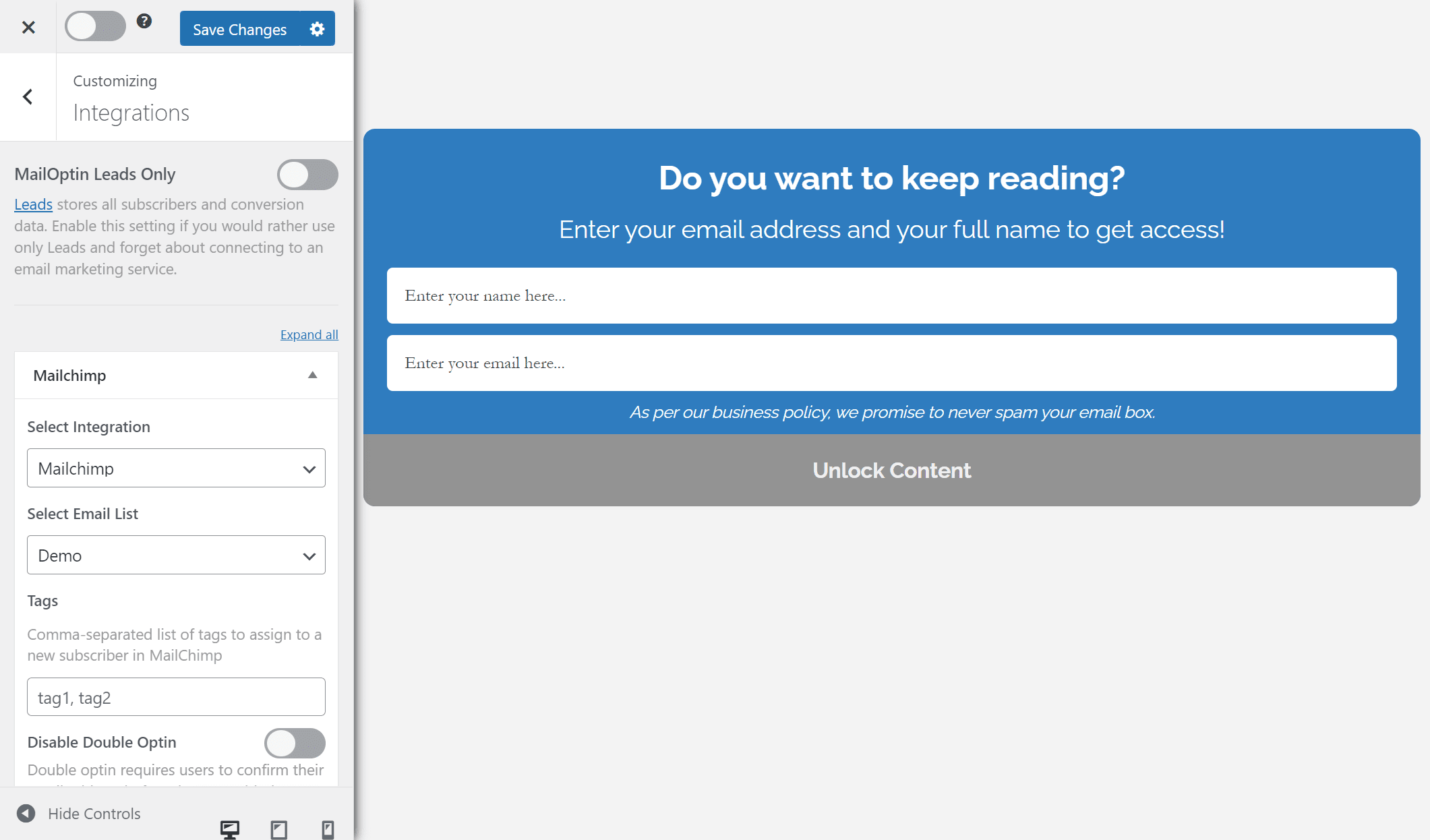
Click the Configuration button and select the Lock Content Below Optin checkbox.
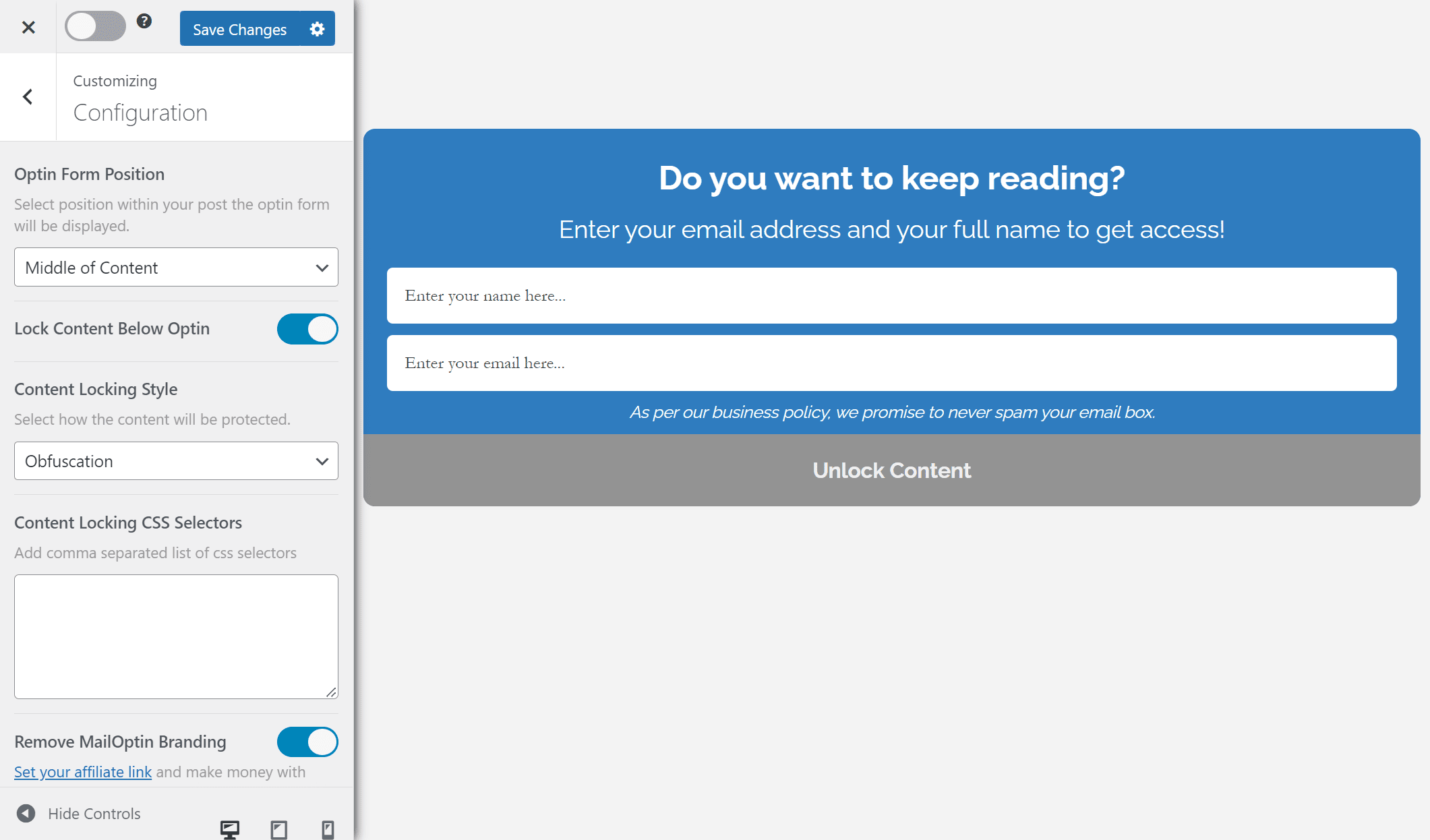
You will see new options appear. For example, you can select how the content locking style will display the restricted content and add custom CSS selectors.
Once you’re done, click on the Save Changes button and remember to activate the opt-in form using the checkbox next to the Save Changes button.
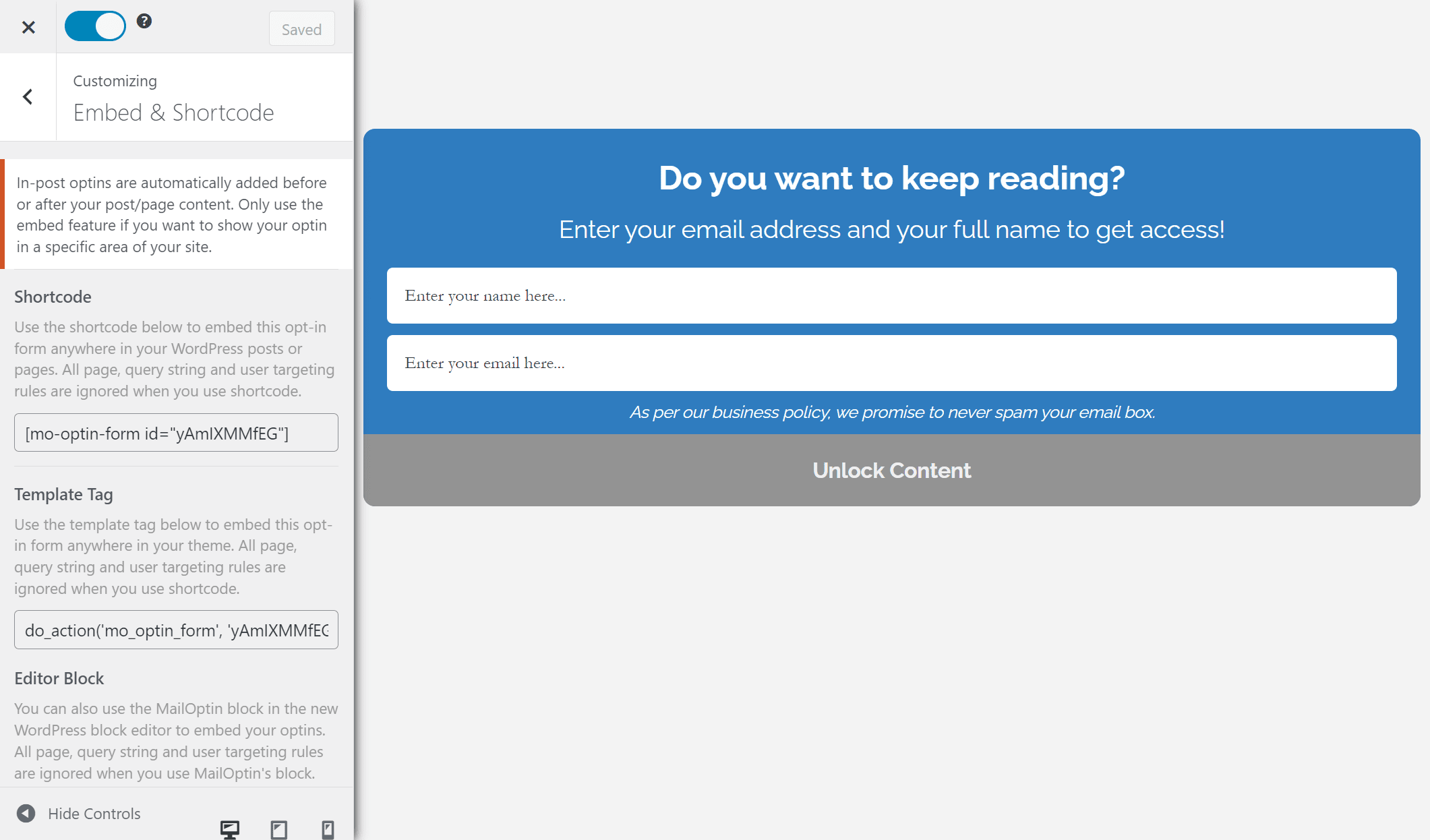
Before leaving the form customization page, click the Embed & Shortcode menu and copy the shortcode for the opt-in form. Also, disable the Show Optin Globally checkbox using the Display Rules > Page Targeting menu.
Next, navigate to the page or post to which you want to add a content locker and paste the shortcode exactly where you want the content lock to appear.
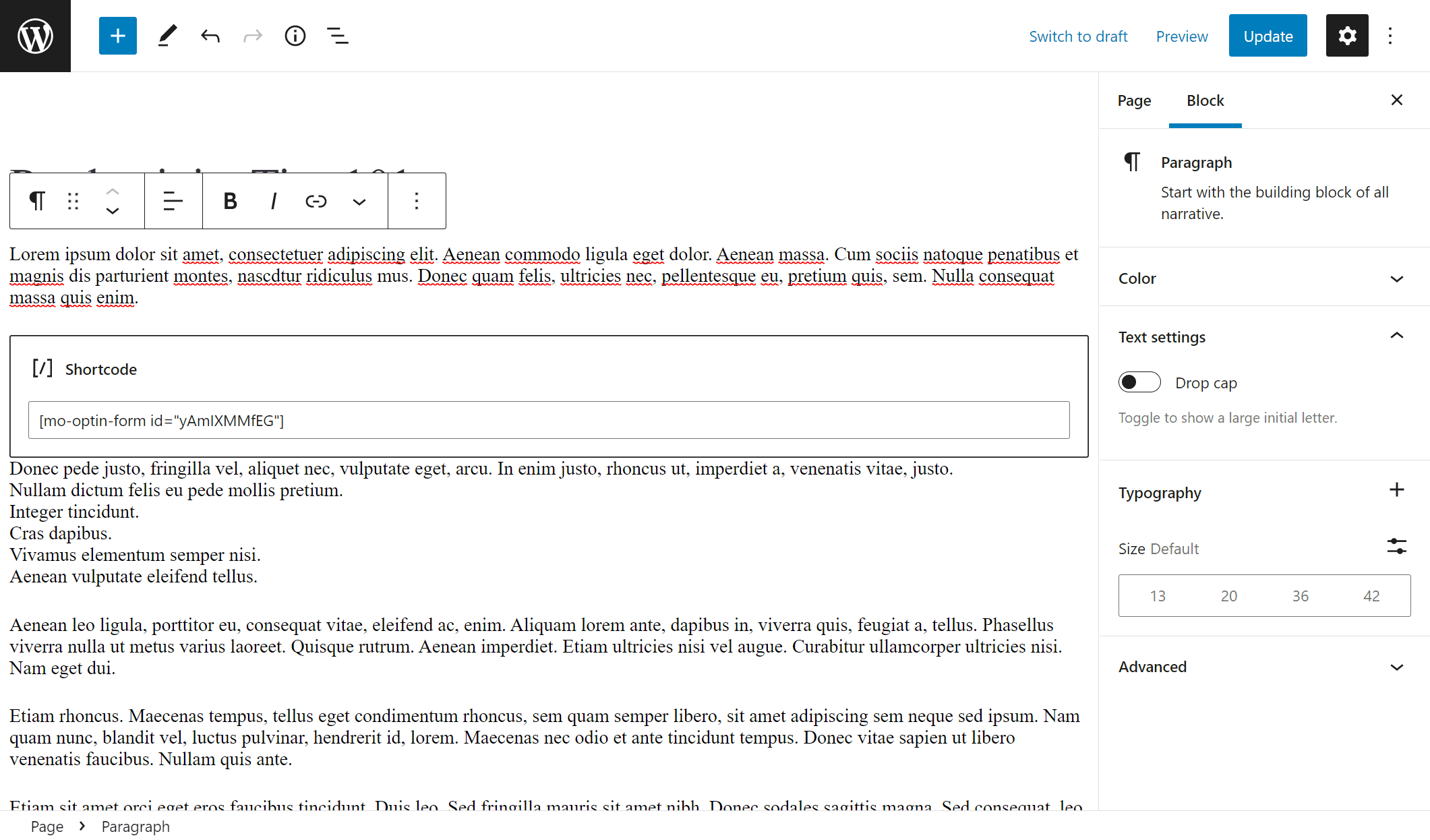
Make sure to click on the Update button to save the changes.
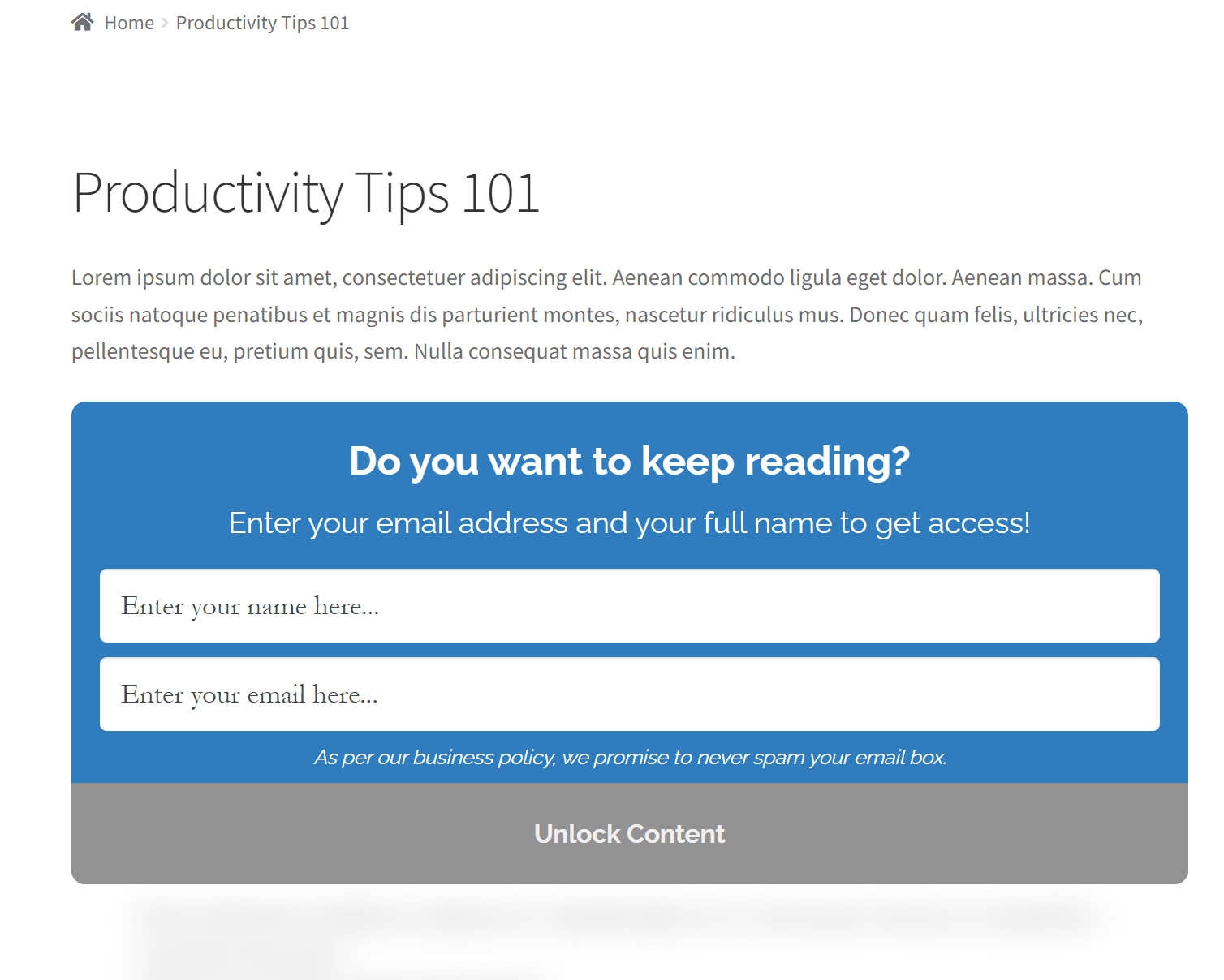
As you can see, the content has been locked right from where we placed the shortcode. Now, site visitors will have to enter their email addresses and name before they can have full access to the premium content on the WordPress site.
Conclusion
Content locking can easily be achieved using a WordPress Content Locker. These content lockers make it easy to lock your content and make your visitors perform various tasks that benefit you, such as subscribing to your list, sharing your article on social media, and paying you a subscription fee.
This article has looked at what content lockers do, their benefits, and how to add content lockers to your WordPress site. We looked at the MailOptin and the ProfilePress content-locking feature, and I believe by the end of this article, you will have been able to set up a content locker on your website.